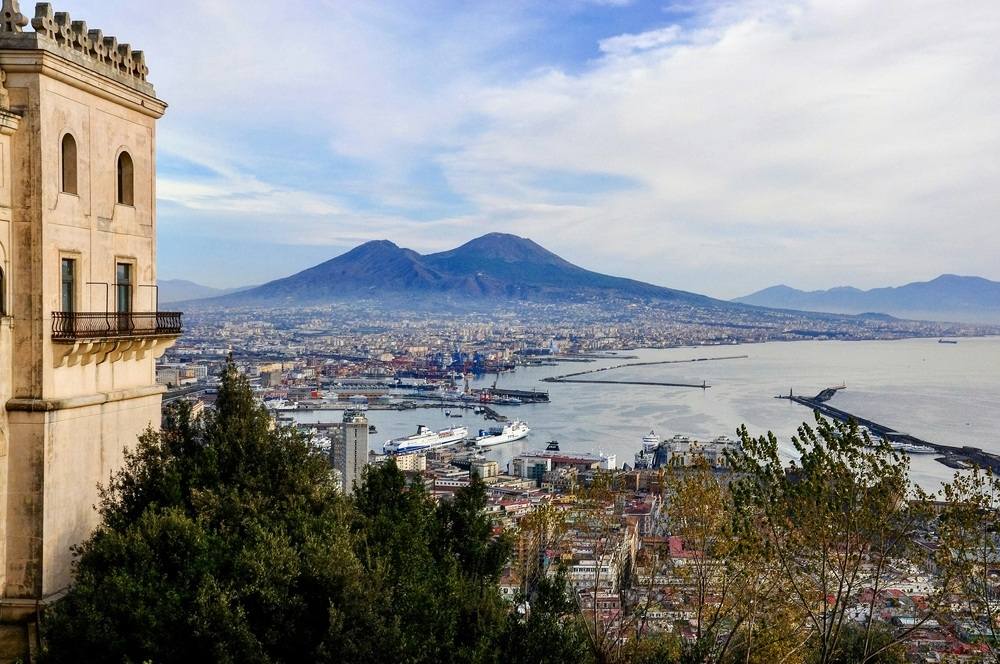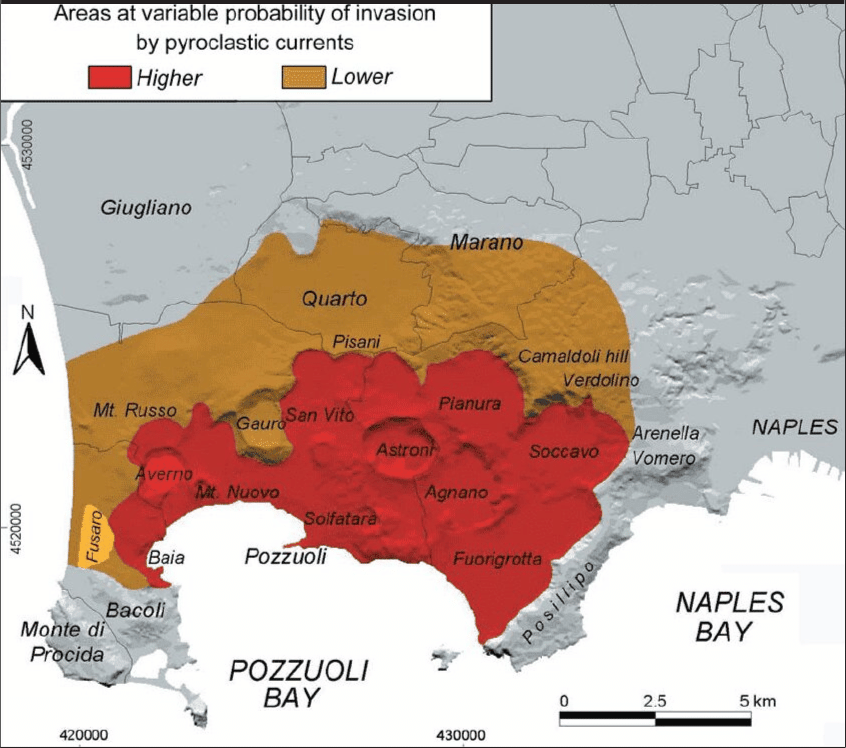
Navigating Resilience at the Edge of Collapse
Campi Flegrei, the famed “Phlegraean Fields” (Fields of Fire) caldera just west of Naples, is not your average volcano. This super-volcanic caldera spans some ~13km across, buried partly beneath the Bay of Naples and largely overlapping with towns like Pozzuoli, Bacoli, and Quarto, and is home to hundreds of thousands of residents. Unlike the iconic silhouette of Mount Vesuvius, Campi Flegrei doesn’t announce itself with a peak; its threat is buried, broad, and harder to pin down and could cause widespread disruption, damage, and loss.
Its ancient legacy is terrifying: at ~39500 BP (apx 37,500 years ago), the Campanian Ignimbrite eruption expelled between 181–265km³ of magma (VEI 7)—Europe’s largest explosive event in 200,000 years.
Another massive event, ~12000BP (apx 10,000 years ago), created the Neapolitan Yellow Tuff (VEI6), carving out much of the modern caldera.
More recently, minor eruptions such as Monte Nuovo in 1538 remind us catastrophe can happen, and did, during modern historical times.
Today, Campi Flegrei is hyperactive. Since the 1950s, the region has experienced cyclical bradyseism; long-timescale ground uplift and subsidence, most recently building more than 2cm/month in 2023–24 ending in seismic swarms surpassing M4.4.
As of mid-2025, scientific instruments are recording sustained ground uplift and swarms of low to moderate earthquakes in the area. These patterns are not new—bradyseism has been documented here for decades. But the pace and consistency of activity over the past three years are pushing Campi Flegrei into sharper public focus. More than 1,000 seismic events were recorded in 2023 alone, with Pozzuoli’s residents reporting cracked walls and sleepless nights.
To call it a crisis in the making is not alarmist. It’s an acknowledgment of risk and interdependence.
This article is based on deep research via all publicly available data, by Alexis AI of PreEmpt.Life. The full set of detailed reports is available free-of-charge to everyone. Just click on the link to access.
A Volcanic Threat Embedded in a Dense Urban Landscape
What makes Campi Flegrei so concerning isn’t only the geological hazard, but the way it intersects with infrastructure, governance, and community life. Around half a million people live in what Italy’s Civil Protection classifies as the “red zone,” meaning they may have to evacuate with little notice.
The threat is multi-dimensional:
. Volcanic ash from even a moderate eruption could cover cities, damage buildings, and halt transportation.
. Seismicity and uplift are already stressing buildings not built for long-term deformation.
. Misinformation and panic are social risks that could outpace the physical hazard itself.
Overlay this with aging infrastructure, slow bureaucracy, and the challenges of coordinating cross-sectoral responses, and the scale of complexity becomes clear.

Authorities Are Preparing, But Constraints Remain
The Italian Civil Protection Department has long had contingency plans for Campi Flegrei. These include:
. A tiered evacuation protocol
. Monitoring networks across seismic, geodetic, and gas emission parameters
. Public communication systems to inform and instruct in real-time
Still, implementation is uneven. Some communities have had robust evacuation drills; others haven’t run one in years. Communication strategies have improved, but trust in institutions varies. Many residents alternate between vigilance and fatigue, made worse by the difficulty of interpreting scientific uncertainty.
Recent gains include:
. The installation of new InSAR (satellite) and GPS monitoring nodes
. EU-supported resilience funds used for retrofitting schools and critical buildings
. Growing use of scenario-based drills incorporating both analog and digital alerts
However, shortfalls remain in inclusive planning, coordinated training, and risk education.
What Naples Can Learn from Elsewhere
This is not the first time a metropolitan area has had to adapt to a nearby volcano. We’ve seen this before:
. Japan’s Sakurajima Volcano: Long-term coexistence has led to daily alert systems, hardened shelters, and education programs embedded in schools.
. Indonesia’s Mount Merapi: Culturally grounded evacuation plans have improved compliance. Sacred sites have even been mapped as part of exclusion zones.
. Iceland’s Reykjavik System: A strong trust in science, combined with public dashboards and near-constant communication, helped manage volcanic swarms in 2024.
From these examples, a few lessons emerge:
- Regular drills reduce panic and increase compliance.
- Trust is built through transparency, not through one-off announcements.
- Cultural integration—rituals, storytelling, and place-based memory, helps turn preparedness into something that feels real, not abstract.
False Alarms and the Risk of Inaction
One of the biggest challenges is maintaining credibility and preparedness in the face of uncertainty. Evacuations are costly, disruptive, and politically risky. But so is waiting too long.
False alarms can erode public trust, especially when evacuation orders never lead to an eruption. On the other hand, a failure to act quickly enough could have catastrophic consequences. This tension isn’t unique to Campi Flegrei, but the stakes here are amplified by population density and economic reliance on tourism, logistics, and small business ecosystems.
It doesn’t help that much of the public doesn’t distinguish between uplift caused by gas movement, and uplift driven by rising magma. Without clear explanations, people either panic unnecessarily or ignore important signals. Both outcomes increase vulnerability.
Looking Ahead: Where Strategy Meets Social Resilience
The future calls for a systems approach that integrates:
. Scientific modelling of eruptive scenarios (VEI 3-6) with public planning
. Investment in “analog + digital” communication tools
. School and workplace readiness programs
. Real-time dashboards that feed into media and public warning systems
. Local rituals and memorials that acknowledge past events and ready people for future ones
One strong recommendation is to invest in “mesh mutual-aid networks”; community-led groups that share updates, support neighbors, and close response gaps during alerts. These networks already show promise in other contexts and could be piloted in Naples’ most at-risk districts.
We also need to move past the idea that resilience means perfection. It doesn’t – it means creating space for adaptive decisions, fallback options, and shared responsibility.
Where PreEmpt.Life Can Add Value
For all the agencies working to prepare Naples, the pressure is high, the risks are dynamic, and the coordination is complex. This is where a decision intelligence ecosystem like PreEmpt.Life becomes not just useful, but necessary.
PreEmpt.Life helps:
. Stress-test different volcanic and seismic scenarios over time
. Align emergency protocols with behavioral insights from affected populations
. Simulate evacuation logistics with changing infrastructure constraints
. Evaluate the effectiveness of communication tools in real-time
By offering a flexible platform for foresight, community insight, and planning audits, PreEmpt.Life makes it easier to move from static contingency plans to living systems of readiness. For a place like Naples, that shift isn’t optional, it’s urgent.
Final Thought
Resilience isn’t a buzzword here. For Campi Flegrei, it’s the difference between an orderly, community-led response and a chaotic, avoidable disaster. The good news is: tools, knowledge, and strategies already exist, but they require leadership willing to act in advance, not just in hindsight.
If you’re a policymaker, planner, consultant, or strategist working near zones of complex risk, ask yourself: Are you making decisions from static plans or from living foresight? If the answer is the former, it’s time to evolve.
Visit PreEmpt.Life to explore how we support foresight-led, community-grounded risk planning, in Naples and beyond.
